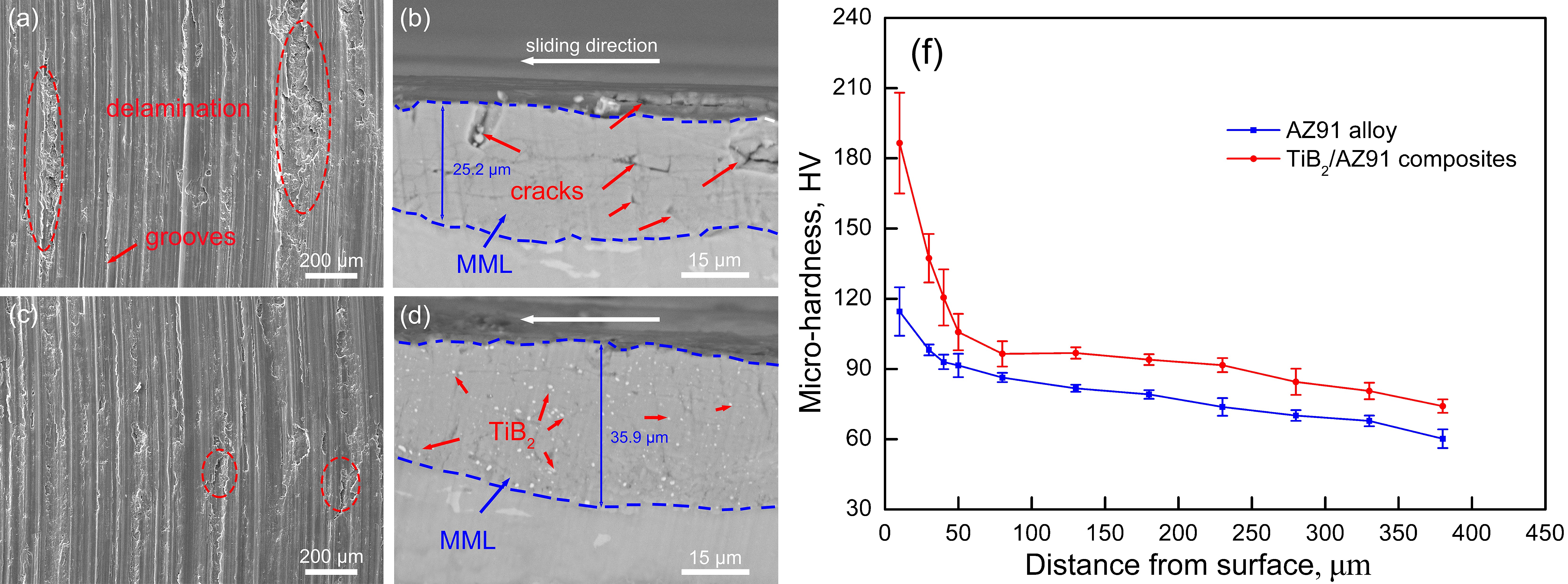the subsurface of AZ91 matrix alloy, indicating relative lower strength of AZ91 alloy can not support the MML(mechanical mixed layer) and thus these cracks nucleate, propagate and lead to MML or subsurface delamination during dry sliding wear.
It is obvious that the micro-hardness of cross section of composites worn surface is much higher than that of AZ91 matrix alloy shown in Fig. 1 (f).

Figure 1 - SEM micrograph of worn surface for (a) AZ91 matrix alloy and (c) TiB2/AZ91 composites; SEM micrograph of cross section for (b) AZ91 matrix alloy and (d) TiB2/AZ91 composites at the sliding speed of 0.75 m/s under normal load of 37.5 N;(f) Micro-hardness of subsurface layers for AZ91 matrix alloy and TiB2/AZ91 composites at the sliding speed of 0.75 m/s under normal load of 37.5 N.
DISCUSSION: At high cyclic normal loads and sliding speeds, the working hardening in the subsurface is pronounced according to the reports [4, 6]. It is noteworthy that the micro-hardness of MML (distance lower than 50 μm) for composites is increased sharply compared with AZ91 matrix alloy. In other words, the capacity of work hardening for Mg matrix composites containing nanosized TiB2 particles is improved remarkably compared to unreinforced AZ91 matrix alloy. This is ascribed to the presence of fine and dispersed TiB2 particles in composites, which leads to a high obstacle effect for dislocations moving during the deformation. Similar results have been done in report [8] that nano-Al2O3 particles reinforced AZ31 composites possess excellent wear resistance compared to pure Mg and AZ31 alloy at high speeds and normal loads due to the higher work hardening rate. Therefore, the higher hardness and strength of subsurface in composites due to high work hardening rate is enough to support the subsurface and beneficial to the increase of wear resistance. Meanwhile, the absence of cracks in MML of composites (Fig. 1 (d)), as well as larger MML thickness of 35.9 μm than that of 25.2 μm thickness in AZ91 matrix alloy, also confirm the above results.
By comparison, the improvement of wear resistance for TiB2/AZ91 composites can be explained as follows. First, the addition of TiB2 particles reduces the abrasive wear at lower sliding speeds and normal loads [3] due to the higher hardness and strength of the composites as discussed in Table 1 of section 3.3 (not shown). Besides, the higher work hardening rate of composites at high sliding speeds and normal loads results in a high surface hardness with a protective effect on MML, which is contributed to the reduction of delamination and excellent wear resistance.
REFERENCES: 1. I.J. Polmear, Mater. Sci. Technol. (1994), 2. B.L. Mordike, Mater. Sci. Eng. A (2001), 3. R.L. Deuis, Compos. Sci. Technol. (1997), 4. N. Kumar, Tribol. Int. (2016), 5. S. García-Rodríguez, Wear (2017), 6. P. Seenuvasaperumal, Tribol. Int. (2017), 7. B. Selvam, Mater. Des. (2014), 8. Q.B. Nguyen, Tribol. Int. (2015), 9. S.C. Tjong, Mater. Sci. Eng. R. Rep. (2000), 10. R.G. Munro, J. Res. Natl. Inst. Stand. Technol. (2000),11. P. Xiao, Mater. Sci. Eng. A (2018).